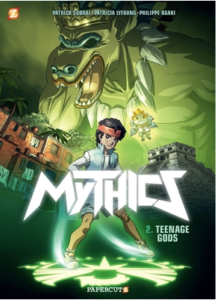This has got to be one of the most beautiful anime-inspired comic book titles for young readers out there today. Despite the creative teams varying between each of the three issues that make up this trade paperback, the quality is uniformly high, and the art style doesn’t deviate so much between issues as to seem jarring. If anything, having different artists helps solidify the vastly differing personalities of the three heroes introduced here, one to each issue. My favorite art was probably in Alice Picard’s illustrations of Parvati’s story, with gorgeous colors by Magali Paillat. Which isn’t at all to throw shade on Jerome Alquie’s artwork of Miguel’s story, or Frederic Charve’s and again Ms Paillat’s on Neo’s. Parvati’s was likely my favorite art-wise because the story lent itself to cuteness plus beauty a little more than the other two did. For cripes’ sake, there’s a tiger that turns into the most adorable housecat! I was the embodiment of the hearteyes emoji every time Shahruk-kitty was on the page.
 Unfortunately, Parvati’s tale was also the one that made me wonder whether a sensitivity consultant had been brought in to look over this book. As opposed to the Aztec and Ancient Greek mythos referenced in the other issues in this collection, Hinduism is a major living religion, and seeing the goddess Kali used as an embodiment of evil made even this non-Hindu reader cringe. I’ll freely admit that I don’t know for sure whether her depiction in this issue is actually offensive to Hindus but knowing that a sensitivity reader had gone through this would have allayed my fears significantly.
Unfortunately, Parvati’s tale was also the one that made me wonder whether a sensitivity consultant had been brought in to look over this book. As opposed to the Aztec and Ancient Greek mythos referenced in the other issues in this collection, Hinduism is a major living religion, and seeing the goddess Kali used as an embodiment of evil made even this non-Hindu reader cringe. I’ll freely admit that I don’t know for sure whether her depiction in this issue is actually offensive to Hindus but knowing that a sensitivity reader had gone through this would have allayed my fears significantly.
What did concern me as a secular reader was the odd attitude to vaccines, which smelled a lot like the nonsense anti-vaxxers in America have been spouting in recent times. It’s true that any vaccine that’s been rushed to market without sufficient testing should be considered skeptically, and it’s true that we should be careful what we put in our bodies, but the vast majority of vaccines are beneficial and shouldn’t be at all controversial: a nod to this latter would have gone a long way to reassuring me that this wasn’t anti-vaxx dog whistling.
Those issues aside, it was a very cute story about a go-getting young Indian girl who discovers she’s been chosen by the goddess Durga to be her avatar in the fight against Evil. Mumbai is suffering strange outbreaks of a super-rage disease, where the victims become mindlessly destructive zombies. Overachiever Parvati Patel is on a school trip to the zoo when another outbreak occurs, and the goddess Durga comes to her to reveal her powers. Parvati is eager to fight Evil, even if it means breaking her own heart a little in the process.
This is definitely a contrast to issue 2, where our hero Miguel is engaging in the modern equivalent of teenage street racing, skateboarding over the rooftops of Mexico City with his rival Joaquim, each representing their gang in a contest to determine control of the city. When the boys are busted by Miguel’s Tio Roberto, who happens to be a cop, they’re sent to do community service after school, helping out the rich, and allegedly one-time gangster, El Gigante distribute food and clothes to the poor. An accident at the warehouse where they’re working triggers Miguel’s connection to Quetzalcoatl, but Miguel is certainly far more skeptical of his ancestor god than Parvati was of hers.
Neo in issue 3 is even worse, wanting very little to do with Hercules even as the Greek god helps him save the lives of his very naughty younger siblings. Neo only wants to make a lot of money fast, embracing Hercules’ gift of strength in order to better his cage-fighting abilities. Rather hilariously, he’s still an ungrateful brat even after reluctantly defeating evil. Much of his terrible attitude stems from the fact that Neo and his family used to be rich until his father was ruined and subsequently died. Now his mother works three jobs to support her family, but her horrid children shirk school and responsibilities while dreaming of their old lives, even as their mom tries to get them to adjust to their new reality. That I didn’t automatically hate any of those kids is a testament to Philippe Ogaki’s writing: I might have not loved some of his choices in Parvati’s story, but I do very much respect his ability to realistically depict diverse young people thrown into extraordinary circumstances. Patrick Sobral, who wrote the second issue with the help of Fabien Dalmasso, also does a wonderful job with Miguel and his relationships with his family, deity and friends.
Overall, this is a beautiful project with several questionable narrative choices in the first part of the book. Credit goes to the seamless translation from the French by Elizabeth S Tieri. I’ll definitely be looking out for more installments, but can understand why other people might choose to skip this series.
The Mythics Vol 2: Teenage Gods by Philippe Ogaki, Patrick Sobral, Fabien Dalmasso, Alice Picard, Jerome Alquie, Frederic Charve & Magali Paillat was published December 29th, 2020 by Papercutz, and is available from all good booksellers, including
Want it now? For the Kindle version, click here.
